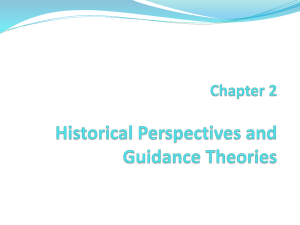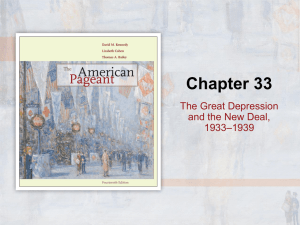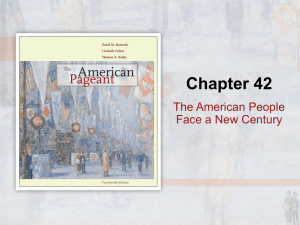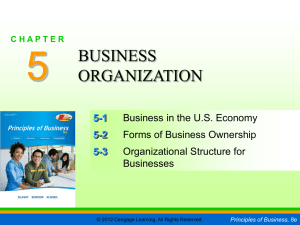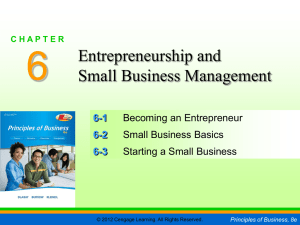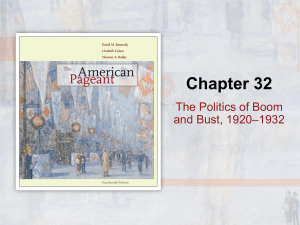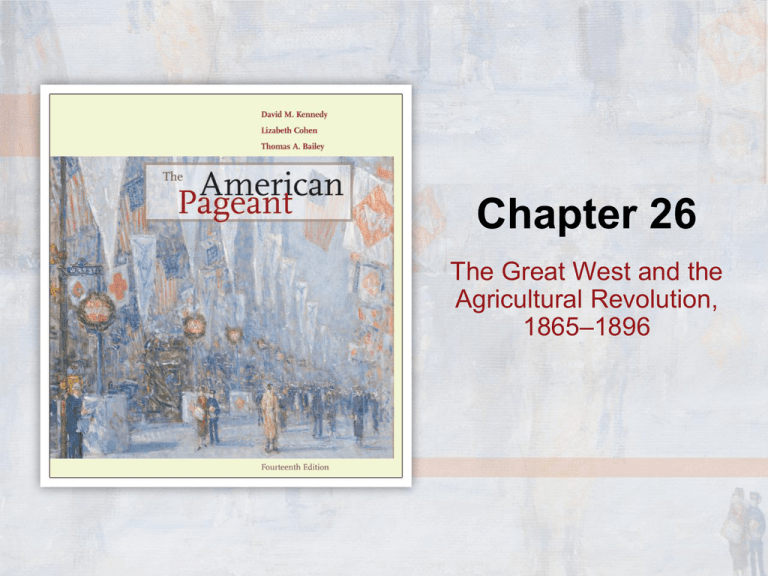
Chapter 26
The Great West and the
Agricultural Revolution,
1865–1896
Question
All of the following are true of the Reservation
System EXCEPT
a) allotted land with designated boundaries to Native
American tribes in the west.
b) began in the 1850s and ended with the Dawes
Severalty Act of 1887.
c) within these reservations, most land was owned
individually, rather than used communally.
d) the U.S. government encouraged and sometimes
violently coerced Native Americans to stay on the
reservations at all times.
Copyright © Cengage Learning. All rights reserved.
26 | 2
Answer
All of the following are true of the Reservation
System EXCEPT
a) allotted land with designated boundaries to Native
American tribes in the west.
b) began in the 1850s and ended with the Dawes
Severalty Act of 1887.
c) within these reservations, most land was owned
individually, rather than used communally. (correct)
d) the U.S. government encouraged and sometimes
violently coerced Native Americans to stay on the
reservations at all times.
Hint: See pages 635–636.
Copyright © Cengage Learning. All rights reserved.
26 | 3
Question
All of the following were true of the Battle of Little Bighorn
EXCEPT
a) it was a particularly violent example of the warfare between
whites and Native Americans in the late nineteenth century.
b) it was also known as “Custer’s Last Stand.”
c) in two days, the combined forces of over 2,000 Sioux,
Cheyenne, and Arapaho Indians killed more than 250 U.S.
soldiers, including Custer.
d) the U.S. government tried to defend white gold-seekers from
Native Americans who were trying to stay
on reservations.
Copyright © Cengage Learning. All rights reserved.
26 | 4
Answer
All of the following were true of the Battle of Little Bighorn
EXCEPT
a) it was a particularly violent example of the warfare between
whites and Native Americans in the late nineteenth century.
b) it was also known as “Custer’s Last Stand.”
c) in two days, the combined forces of over 2,000 Sioux,
Cheyenne, and Arapaho Indians killed more than 250 U.S.
soldiers, including Custer.
d) the U.S. government tried to defend white gold-seekers from
Native Americans who were trying to stay
on reservations. (correct)
Hint: See pages 637–638.
Copyright © Cengage Learning. All rights reserved.
26 | 5
Question
All of the following were true of the Battle of Wounded
Knee EXCEPT
a) it resulted from an attempt by the federal government to outlaw
the sacred Sun Dance.
b) its origins lay in the fact that the U.S. government had formally
rejected the policy of trying to assimilate Native Americans into
white culture.
c) when the “Ghost Dance” cult later spread to the Dakota Sioux,
the army bloodily stamped it out in 1890.
d) an estimated two hundred Indian men, women, and children
were killed, as well as twenty-nine invading soldiers.
Copyright © Cengage Learning. All rights reserved.
26 | 6
Answer
All of the following were true of the Battle of Wounded
Knee EXCEPT
a) it resulted from an attempt by the federal government to outlaw
the sacred Sun Dance.
b) its origins lay in the fact that the U.S. government had formally
rejected the policy of trying to assimilate Native Americans into
white culture. (correct)
c) when the “Ghost Dance” cult later spread to the Dakota Sioux,
the army bloodily stamped it out in 1890.
d) an estimated two hundred Indian men, women, and children
were killed, as well as twenty-nine invading soldiers.
Hint: See page 639.
Copyright © Cengage Learning. All rights reserved.
26 | 7
Question
All of the following were true of the Dawes
Severalty Act EXCEPT it
a) was the misbegotten offspring of the movement to
reform Indian policy.
b) reflected the forced-civilization views of the
reformers.
c) dissolved many tribes as legal entities and wiped out
tribal ownership of land.
d) granted full citizenship to all Indians.
Copyright © Cengage Learning. All rights reserved.
26 | 8
Answer
All of the following were true of the Dawes
Severalty Act EXCEPT it
a) was the misbegotten offspring of the movement to
reform Indian policy.
b) reflected the forced-civilization views of the
reformers.
c) dissolved many tribes as legal entities and wiped out
tribal ownership of land.
d) granted full citizenship to all Indians. (correct)
Hint: See page 639.
Copyright © Cengage Learning. All rights reserved.
26 | 9
Question
All of the following were true of the mining industry
EXCEPT
a) lynch law and hempen vigilante justice, as in early California,
preserved a crude semblance of order in the towns.
b) when the “diggings” petered out, the gold-seekers decamped,
leaving eerily picturesque “ghost towns.”
c) smashing the gold-bearing quartz was relatively
inexpensive, so it could be undertaken by independent
gold-washers.
d) miners were replaced by impersonal corporations, with their
costly machinery and trained engineers.
Copyright © Cengage Learning. All rights reserved.
26 | 10
Answer
All of the following were true of the mining industry
EXCEPT
a) lynch law and hempen vigilante justice, as in early California,
preserved a crude semblance of order in the towns.
b) when the “diggings” petered out, the gold-seekers decamped,
leaving eerily picturesque “ghost towns.”
c) smashing the gold-bearing quartz was relatively
inexpensive, so it could be undertaken by independent
gold-washers. (correct)
d) miners were replaced by impersonal corporations, with their
costly machinery and trained engineers.
Hint: See page 644.
Copyright © Cengage Learning. All rights reserved.
26 | 11
Question
All of the following were true of the Homestead Act
EXCEPT
a) it allowed a settler to acquire as much as 160 acres
of land.
b) settlers had to live on the land for five years,
improving it, and pay a nominal fee of about $30.
c) it marked a drastic departure from previous policy.
d) before the act, public land had been given away to
encourage a rapid filling of empty spaces and to
provide a stimulus to the family farm.
Copyright © Cengage Learning. All rights reserved.
26 | 12
Answer
All of the following were true of the Homestead Act
EXCEPT
a) it allowed a settler to acquire as much as 160 acres
of land.
b) settlers had to live on the land for five years,
improving it, and pay a nominal fee of about $30.
c) it marked a drastic departure from previous policy.
d) before the act, public land had been given away to
encourage a rapid filling of empty spaces and to
provide a stimulus to the family farm. (correct)
Hint: See page 645.
Copyright © Cengage Learning. All rights reserved.
26 | 13
Question
All of the following were true of the Populists
EXCEPT
a) they emerged in the early 1890s out of the Farmers’
Alliances.
b) these frustrated farmers allied themselves with Wall
Street and the “money trust.”
c) they called for nationalizing the railroads, telephone,
and telegraph; instituting a graduated income tax.
d) they wanted the free and unlimited coinage of silver.
Copyright © Cengage Learning. All rights reserved.
26 | 14
Answer
All of the following were true of the Populists
EXCEPT
a) they emerged in the early 1890s out of the Farmers’
Alliances.
b) these frustrated farmers allied themselves with Wall
Street and the “money trust.” (correct)
c) they called for nationalizing the railroads, telephone,
and telegraph; instituting a graduated income tax.
d) they wanted the free and unlimited coinage of silver.
Hint: See page 657.
Copyright © Cengage Learning. All rights reserved.
26 | 15
Question
The Pullman Strike focused on the problems of
a) railroad workers.
b) farmers.
c) steel workers.
d) anarchists.
Copyright © Cengage Learning. All rights reserved.
26 | 16
Answer
The Pullman Strike focused on the problems of
a) railroad workers. (correct)
b) farmers.
c) steel workers.
d) anarchists.
e) Hint: See page 658.
Copyright © Cengage Learning. All rights reserved.
26 | 17
Question
All of the following were true of the “Fourth Party System”
EXCEPT
a) McKinley’s election in 1896 imparted a new character to the
American political system.
b) it signaled a break with the previous “third party system,” in
place since 1860.
c) it was accompanied by diminishing voter participation in
elections, the weakening of party organizations, and the fading
away of issues like the money question and civil-service
reform.
d) it saw remarkably high voter turnouts and close contests
between Democrats and Republicans.
Copyright © Cengage Learning. All rights reserved.
26 | 18
Answer
All of the following were true of the “Fourth Party System”
EXCEPT
a) McKinley’s election in 1896 imparted a new character to the
American political system.
b) it signaled a break with the previous “third party system,” in
place since 1860.
c) it was accompanied by diminishing voter participation in
elections, the weakening of party organizations, and the fading
away of issues like the money question and civil-service
reform.
d) it saw remarkably high voter turnouts and close contests
between Democrats and Republicans. (correct)
Hint: See page 664.
Copyright © Cengage Learning. All rights reserved.
26 | 19
Question
All of the following were true of the Gold Standard Act of
1900 EXCEPT
a) with the return of prosperity, the money issue that had
overshadowed politics since the Civil War gained increasing
traction.
b) it passed over last-ditch silverite opposition, and provided that
the paper currency be redeemed freely in gold.
c) nature and science gradually provided an inflation that the
“Gold Bug” East had fought so frantically to prevent.
d) moderate inflation took care of the currency needs of an
explosively expanding nation, as its circulatory system greatly
improved.
Copyright © Cengage Learning. All rights reserved.
26 | 20
Answer
All of the following were true of the Gold Standard Act of
1900 EXCEPT
a) with the return of prosperity, the money issue that had
overshadowed politics since the Civil War gained increasing
traction. (correct)
b) it passed over last-ditch silverite opposition, and provided that
the paper currency be redeemed freely in gold.
c) nature and science gradually provided an inflation that the
“Gold Bug” East had fought so frantically to prevent.
d) moderate inflation took care of the currency needs of an
explosively expanding nation, as its circulatory system greatly
improved.
Hint: See page 665.
Copyright © Cengage Learning. All rights reserved.
26 | 21

